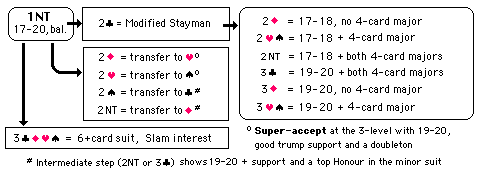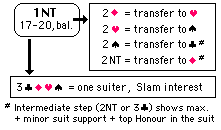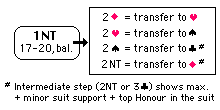(Down - Up -
Top)
IBR 9.3 - Power 1NT
without 5-card majors
(Recommended !)
The Power 1NT opening can stand entirely on its
own and can be
used within any simple NT bidding arrangement.
The
great thing is
that your Partner must respond with 6 points or
more, no matter
what.
By not including 5-card major suits
in the 1NT
opening (which I much prefer personally), you can use
the system I recommend as shown
below. It uses a slightly modified
version of the Stayman Convention, where traditional
Stayman replies made at the 2-
level show 17-18 points, and mirror replies at the 3-
level show 19-20 points.

(Note : Balanced hands with
5332 shape and a 5 card
minor can be included in the 1NT opening.)
The 2NT response is used as a transfer bid and therefore
is not available as the regular invitation bid to the
Responder. To find out Opener's points range Responder
must therefore bid
2♣ regardless
whether he holds a 4-card major or not.
After
Opener's rebid of 2NT or 3♣ (showing both majors),
the Responder (if he does hold a 4-card major) can use
transfers : bidding 3♦
as transfer to 3♥,
or bidding 3♥ as
transfer to 3♠.
(If you wish to keep it simple you can also use the
traditional response system as shown in the Basic
Bidding
Guide page 3,
except that
all responses are now 2 points less than shown.)
Here follow two examples.
| Ex. 1
| Opener (W)
♠ - A K
♥ - K J 8 5
♦ - A 9 5 3
♣ - Q 9 2
|
| Responder (E)
♠ - Q 8 4 2
♥ - A 9 7 3
♦ - 8 7 4
♣ - 8 6
|
| Comment
Opener's 2♥ shows a 4-
card major and
17-18 pts. Responder passes
with only 6 HCP.
|
| |
Bidding : (W) 1NT -
2♣ - 2♥ - Pass
|
| Ex. 2
| Opener (W)
♠ - A 3
♥ - K J 4
♦ - A Q 10 5
♣ - K Q 9 7
|
| Responder (E)
♠ - 9 7 4 2
♥ - A Q 10 7
♦ - K 9 7
♣ - 6 2
|
| Comment
Opener's reply of 3♦ shows a
maximum 19-20 points
without a 4-card major. Responder signs off with 3NT.
|
| |
Bidding : (W) 1NT -
2♣ - 3♦ - 3NT -
Pass
|
(Down - Up -
Top)
IBR 9.4 - Power 1NT
with
5-card majors
When including 5-card majors in your
1NT Opening I recommend that you combine
it with the Extended Stayman Convention.
- It enables Opener to show his range : minimum = 17-
18 points,
maximum = 19-20 points
- It enables Opener to show both a 4-card or a 5-card
major
- It enables Responder too to show a 5-card
suit
Here is the relevant bidding Diagram.

After Opener has confirmed holding a 4-card
major
(through bidding 2♦
with a minimum
17-18 pts, or with
3♣ with a maximum 19
-20 pts opening
hand) Responder can ask for the 4-card major by bidding
3♦.
After Opener has denied holding a 4-card
major (through
bidding 2NT with a minimum 17-18 pts, or with
3♦ with a maximum 19
-20 pts opening
hand) Responder can show his 5-card major by bidding
3♥ or 3♠.
Here follow two examples.
| Ex. 3
| Opener (W)
♠ - A K
♥ - K Q 8 5
♦ - A 9 5 3
♣ - Q 9 2
|
| Responder (E)
♠ - Q 8 4 2
♥ - A 9 7 3
♦ - 8 7 4
♣ - 8 6
|
| Comment
Opener's 2♦ shows a 4-
card major and
17-18 pts. Responder's 3♦ asks for the major, then
passes
Opener's reply having only 6 HCP.
|
| |
Bidding : (W) 1NT -
2♣ - 2♦ - 3♦ - 3♥ - Pass
|
| Ex. 4
| Opener (W)
♠ - A 3
♥ - K J 9 7 4 2
♦ - A Q 10 5
♣ - K Q 9
|
| Responder (E)
♠ - 8 7 4 2
♥ - A Q 10
♦ - K 9 7 2
♣ - 6 2
|
| Comment
Opener's reply of 3♥ shows a
maximum 19-20 points
and 5 hearts. Responder signs off with 4♥.
|
| |
Bidding : (W) 1NT -
2♣ - 3♥ - 4♥ - Pass
|
(Down - Up -
Top)
IBR 9.5 - Other
responses to a Power 1NT
 Responder hands not suitable for the Stayman enquiry
route are
of two types : weak unbalanced hands normally suitable
for a "Rescue
bid" and 6+card suits of various strength.
Responder hands not suitable for the Stayman enquiry
route are
of two types : weak unbalanced hands normally suitable
for a "Rescue
bid" and 6+card suits of various strength.
Two type of responses to the Power 1NT, shown on
adjacent diagram,
cater for all those hands. They can be used in the
following situations
:
- With weak unbalanced hands go the Transfer
route and pass
after Opener made his transfer bid.
- With 6-11 points and a 6+card suit
also go the
Transfer route, bid to Game after Opener's response.
- With 12-14 points and a 6+card suit
bid 2♣ (Extended Stayman).
If Opener is
minimum (17-18) proceed to Game, if Opener is maximum
proceed to Slam.
- With 15+ points and a 6+card suit, bid
your suit
directly at the 3-level. This shows
interest in Slam even
if Opener is minimum.
When the 1NT Opener is maximum (19-20 pts), has
3+card support for
Responder's major suit and a doubleton, he
makes a super accept, by bidding
his transfer suit at the 3-
level. For example : 1NT -
2♦ - 3♥
 1NT - 2♠
-
2NT
1NT - 2♠
-
2NT
When the Opener, after Responder's transfer request of
2♠ replies with
2NT (instead
of 3♣) he is showing
19-20 points
plus 3+card support and a top Honour (A, K or Q) in
Responder's ♣ suit.
1NT - 2NT - 3♣
Likewise when the Opener, after Responder's transfer
request of 2NT
replies wit 2♣ (instead
of 3♦) he is showing
19-20 points
plus 3+card support and a top Honour (A, K or Q) in
Responder's ♦ suit.
These two additions may reveal that Responder's long
minor suit
can be run for its full length, a strong positive for a
potential
3NT contract.
Here follow two examples.
| Ex. 5
| Opener (W)
♠ - A K
♥ - K 8
♦ - A 9 5 3
♣ - Q J 9 7
|
| Responder (E)
♠ - Q 8 4
♥ - A J 9 7 3
♦ - 8 7 4
♣ - 8 6
|
| Comment
After Opener's transfer Responder passes
having only 7 HCP.
|
| |
Bidding : (W) 1NT -
2♦ - 2♥ - Pass
|
| Ex. 6
| Opener (W)
♠ - K Q 3
♥ - K J 9 7
♦ - A Q 10 5
♣ - A 7
|
| Responder (E)
♠ - A 8 7 4 2
♥ - A Q 10
♦ - K 9 7
♣ - 6 2
|
| Comment
Opener's super-accept of 3♠ shows a
maximum 19-20 points,
3 hearts and a doubleton. Responder confidently bids to
Slam.
|
| |
Bidding : (W) 1NT -
2♥ - 3♠ - 6♠ - Pass
|